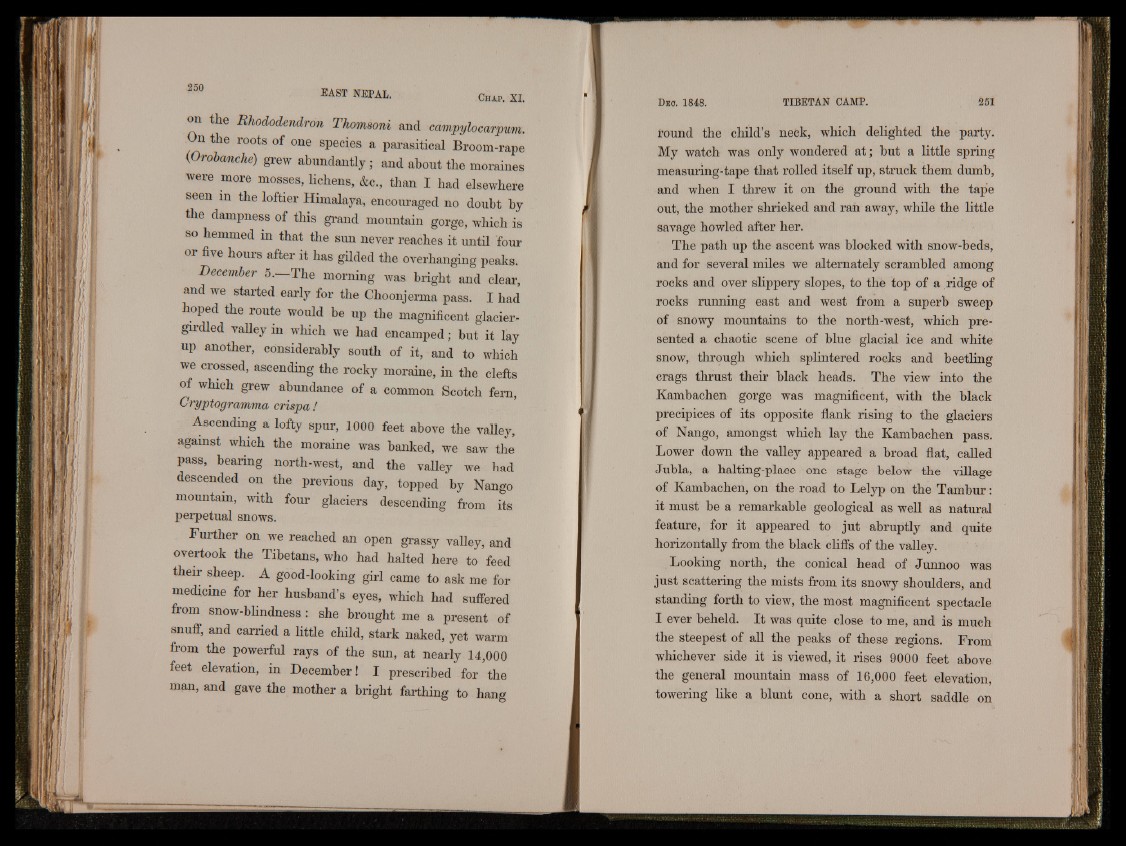
on the Rhododendron Thomsoni and campylocarpum.
On the roots of one species a parasitical Broom-rape
('Orohanche) grew abundantly; and about the moraines
were more mosses, lichens, &c., than I had elsewhere
seen in the loftier Himalaya, encouraged no doubt by
the dampness of this grand mountain gorge, which is
so hemmed in that the sun never reaches it until four
or five hours after it has gilded the overhanging peaks.
December 5.—The morning was bright and clear,
and we started early for the Choonjerma pass. I had
hoped the route would be up the magnificent glacier-
girdled valley in which we had encamped; but it lay
up another, considerably south of it, and to which
we crossed, ascending the rocky moraine, in the clefts
of which grew abundance of a common Scotch fern,
Cryptogramma crispa!
Ascending a lofty spur, 1000 feet above the valley,
against which the moraine was banked, we saw the
pass, bearing north-west, and the valley we had
descended on the previous day, topped by Nango
mountain, with four glaciers descending from its
perpetual snows.
Further on we reached an open grassy valley, and
overtook the Tibetans, who had halted here to feed
their sheep. A good-looking girl came to ask me for
medicine for her husband’s eyes, which had suffered
from snow-blindness: she brought me a present of
snuff, and carried a little child, stark naked, yet warm
from the powerful rays of the sun, at nearly 14,000
feet elevation, in December! I prescribed for the
man, and gave the mother a bright farthing to hang
Pound the child’s neck, which delighted the party.
My watch was only wondered at; but a little spring
measuring-tape that rolled itself up, struck them dumb,
and when I threw it on the ground with the tape
out, the mother shrieked and ran away, while the little
savage howled after her.
The path up the ascent was blocked with snow-beds,
and for several miles we alternately scrambled among
rocks and over slippery slopes, to the top of a . ridge of
rocks running east and west from a superb sweep
of snowy mountains to the north-west, which presented
a chaotic scene of blue glacial ice and white
snow, through which splintered rocks and beetling
crags thrust their black heads. The view into the
Kambachen gorge was magnificent, with the black
precipices of its opposite flank rising to the glaciers
of Nango, amongst which lay the Kambachen pass.
Lower down the valley appeared a broad flat, called
Jubla, a halting-place one stage below the village
of Kambachen, on the road to Lelyp on the Tambur:
it must be a remarkable geological as well as natural
feature, for it appeared to ju t abruptly and quite
horizontally from the black cliffs of the valley.
Looking north, the conical head of Junnoo was
just scattering the mists from its snowy shoulders, and
standing forth to view, the most magnificent spectacle
I ever beheld. I t was quite close to me, and is much
the steepest of all the peaks of these regions. From
whichever side it is viewed, it rises 9000 feet above
the general mountain mass of 16,000 feet elevation,
towering like a blunt cone, with a short saddle on